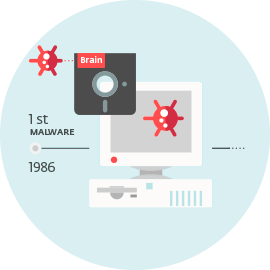Malware definition
The definition of malware encompasses all sorts of online threats – common malware types include Trojan horses, ransomware, viruses, computer worms, and banking malware. Most malware threats cannot damage physical hardware or networks, but it can steal, encrypt, or delete data, hijack core computer functions, and spy on a user’s computer activity.
For a regular user, it is hard to say which file is malware and which isn’t. An updated anti-malware program is the best defence – these maintain vast databases of previously seen malware and continually scan to discover and counter new ones.

Types of malware
Trojan horses – a type of malware threat that disguises itself as a normal file or program to trick users into downloading and installing it. Once installed, a cybercriminal can take control of the infected computer – allowing them to steal data, access sensitive information, or install more malware.
Ransomware – this specific kind of malware is used for extortion, blocking the screen or encrypting a user’s data so it can’t be accessed. Ransomware holds the computer system captive and demands payment from the user in order to regain access.
Viruses – this is a malware type that is capable of copying itself and spreading to other computers, much like a human virus. It modifies legitimate host files or programs, and executes its code when the user launches the infected program.
Computer worms – these can be classified as a type of virus – the key difference is that worms are self-replicating and can spread independently while viruses rely on human actions to spread. Computer worms exploit vulnerabilities in the user’s operating system and can steal data, delete files, or create botnets.
Banking malware – banking malware disguises itself as a legitimate app or program, tricking the user into installing It on their device. Once installed, the program will ask for banking details, which then allows the cybercriminal to steal credentials or transfer money from the victim’s bank account.
Read more
How to protect against malware?
The first step is to keep all software up-to-date, including the operating system and all applications. As well as improving the software and fixing bugs, updating your software will also patch vulnerabilities that could be exploited by cybercriminals and their malicious code.
You can detect and remove malware threats for free using our easy-to-use online scanner. The one-time scan is quick and easy, can be used without installation and is a great way to identify vulnerabilities and remove these in the short-term.
Even today one of the most effective vectors for infection is the weakest link in the chain - the human being. Well-crafted emails with malicious attachments have proven to be an efficient yet cheap way to compromise a system. And it only takes one wrong click to achieve it.
Therefore, a reliable anti-malware software is the best way to stop potential attacks.
Regular backups stored on an offline hard drive are another way to counter malware, allowing the user to easily replace any data that might have been damaged, corrupted or encrypted by the attackers.

Brief history
The first ever recorded PC virus was Pakistani Brain in early 1986. It tried to stay as stealthy as possible by infecting the boot sector of floppy disks. It spread globally in a matter of weeks, which is pretty remarkable, given that it was distributed only via 5.25" diskettes.
Since then, malware has evolved into various forms, its creators always finding new ways of afflicting victims. Internet use has made its distribution much easier and enabled malware authors to spread their “evil wares” to a global network of potential victims.
Notable examples
ESET offers you an award-winning antivirus
ESET HOME Security Premium
Powerful, multilayered protection to encrypt sensitive data, manage passwords easily, secure online transactions and more. A user-friendly solution for enhanced privacy online. Secures Windows, macOS, Android, and iOS devices.



